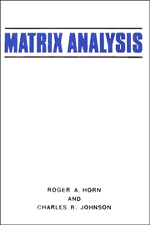Book contents
- Frontmatter
- Contents
- Preface
- Chapter 0 Review and miscellanea
- Chapter 1 Eigenvalues, eigenvectors, and similarity
- Chapter 2 Unitary equivalence and normal matrices
- Chapter 3 Canonical forms
- Chapter 4 Hermitian and symmetric matrices
- Chapter 5 Norms for vectors and matrices
- Chapter 6 Location and perturbation of eigenvalues
- Chapter 7 Positive definite matrices
- Chapter 8 Nonnegative matrices
- Appendices
- References
- Notation
- Index
Chapter 5 - Norms for vectors and matrices
Published online by Cambridge University Press: 05 June 2012
- Frontmatter
- Contents
- Preface
- Chapter 0 Review and miscellanea
- Chapter 1 Eigenvalues, eigenvectors, and similarity
- Chapter 2 Unitary equivalence and normal matrices
- Chapter 3 Canonical forms
- Chapter 4 Hermitian and symmetric matrices
- Chapter 5 Norms for vectors and matrices
- Chapter 6 Location and perturbation of eigenvalues
- Chapter 7 Positive definite matrices
- Chapter 8 Nonnegative matrices
- Appendices
- References
- Notation
- Index
Summary
Introduction
If one has several vectors in Cn or several matrices in Mn, what might it mean to say that some are “small” or that others are “large”? Under what circumstances might we say that two vectors are “close together” or “far apart”?
Questions of “size” and “proximity” in a two- or three-dimensional real vector space usually refer to Euclidean distance. The Euclidean length of a vector z ∈ Rn is (zTz)½ = and z is said to be “small” (with respect to this measure) if this nonnegative real number is small. The vectors x and y, furthermore, are “close” if the Euclidean length of the difference z = x–y is a small number.
What may be said about the “size” of matrices, which may be thought of as vectors in a higher-dimensional space? What about vectors in infinite-dimensional spaces? What about complex vectors? Are there useful ways to measure the “size” of real vectors other than by Euclidean length?
One way to answer these questions is to study norms, or measures of size, of matrices and vectors. Norms may be thought of as generalizations of Euclidean length, but the study of norms is more than an exercise in mathematical generalization. It is necessary for a proper formulation of notions such as power series of matrices, and it is essential in the analysis and assessment of algorithms for numerical computations.
- Type
- Chapter
- Information
- Matrix Analysis , pp. 257 - 342Publisher: Cambridge University PressPrint publication year: 1985
- 4
- Cited by



